Controlling Magnetization in Ferromagnetic Semiconductors by Current-Induced Spin-Orbit Torque
Abstract
1. Introduction and Background Information
1.1. Spin Polarization of Electric Current in FM Semiconductors
1.2. Interaction of Magnetization of FMS with Spin-Polarized Current
1.3. Magnetic Anisotropy of Ferromagnetic Semiconductors
2. Materials Preparation and Experimental Methods
2.1. Materials Preparation
2.2. Monitoring Magnetization by Hall Resistance Measurements
3. Experimental Results and Discussion
3.1. Reversal of Normal to Layer Plane
3.1.1. Mechanism of Magnetization Reversal
3.1.2. Example of Magnetization Switching Measurements
3.1.3. Quantification of Dresselhaus and Rashba Fields
3.1.4. Really Field-Free SOT Switching
3.1.5. Efficiency of Spin-Orbit Torque
3.2. In-Plane Magnetization Switching
3.2.1. SOT Magnetization Switching in the Plane of the FMS Film
3.2.2. Quantification of Dresselhaus and Rashba Fields in In-Plane Film
3.2.3. Manipulation of In-Plane Magnetization States by Alternating Current Pulses
4. Summary and Future Directions
- While the fundamental mechanisms of SOT are generally understood, there is a notable lack of systematic quantitative analysis regarding the contributions from FLT and DLT across various materials systems. In particular, one needs to determine the precise magnitudes of these contributions, and one needs to establish how they influence the dynamics of magnetization. In this regard, simulations based on the LLG equation and the relative strengths of FLT and DLT components have already highlighted the critical role of the DLT process in the switching behavior in FMS films [17,47]. Furthermore, simulation studies of SOT switching in the presence of an in-plane external field have emphasized the importance of relative alignments between the torque arising from an external field and the current-induced field-like torque (FLT), which can impede the SOT switching process [17,47]. Future experimental investigation is needed to address the quantitative aspects of FLT and DLT in FMS films, and to adapt specific techniques, such as second-harmonic measurements, which can quantify FLT and DLT contributions separately [48].
- Recognizing that magnetization switching occurs domain-by-domain, a deeper understanding of electrical control of magnetic domain walls is essential, particularly regarding their movement and behavior in the presence of disorder and Dzyaloshinskii-Moriya interactions (DMI) [31]. Clearly domain wall nucleation and propagation are critical to SOT-driven switching. To fully understand SOT switching in crystalline FMSs, numerical simulations using first-principles rules to compute the dynamic evolution of micromagnetic systems are especially important. However, such simulations often face challenges due to their slow computational speed resulting from the need for global convolution for calculating demagnetizing fields and DMI, which require taking into account comprehensive interactions among all units in the specimen. Additionally, limited knowledge about the domain texture and domain wall configuration in FMS films [49], as well as their relations with disorder, complicates these simulations further. Progress in this area will constitute an important step in the development of advanced SOT-based spintronic devices.
- An issue of major importance in developing practical spintronic devices is to achieve field-free (FF) operation of the device. Importantly, SOT-induced magnetization switching without an external magnetic field has already been observed in FMS films exhibiting both in-plane and out-of-plane magnetic anisotropy in certain situations [16,23,38]. Although a qualitative link between such field-free switching and spin polarization aligned with an internal magnetic field has already been established, a comprehensive understanding of FF-SOT switching is still lacking. In addition, it is also necessary to find new ways of achieving FF-SOT switching in FMS films. As already demonstrated by several preliminary studies, this can be achieved by creating broken inversion symmetry in crystalline FMS films by introducing a strain gradient [20,21,30,50], by tilting magnetic anisotropy in the film [25], or by generating an out-of-plane component of spin polarization.
- Even though the SOT switching efficiency in FMS single films is already significantly better than in HM/FM bilayers, it can be further improved via strategic design of structures, involving additional layers that themselves have spin polarization. For example, the surface states of topological insulators (TIs) are protected by time-reversal symmetry and exhibit a Dirac-like linear dispersion characterized by spin-momentum locking. This property makes them particularly attractive for SOT and other spintronic applications. While crystalline FMSs are typically grown on (001) substrates, high-quality hexagonal TIs have been successfully grown on (001) GaAs substrates [51]. This advancement allows for the study of SOT in bilayer systems such as Bi₂Se₃/GaMnAsP. The exotic spin texture of the Dirac cone holds the potential of enhancing SOT efficiency [52]. Specifically, a current flowing through the topological surface states can generate a nonequilibrium spin density with both in-plane and out-of-plane components, thereby inducing torques—both out-of-plane and in-plane—on an adjacent magnetic layer. It is worth noting that crystals exhibiting a giant Rashba effect, such as BiTeI [53] and GeTe [54], as well as various low-dimensional systems [55,56], hold great promise for significant charge-spin conversion and enhanced SOT efficiency when interfaced with FMS layers.
- Finally, search for the most efficient sources of SOT prompts inquiries into the nature of SOT itself, especially in systems with very large spin-orbit coupling and novel spin textures. In this context, it is important to highlight that other FMS systems exhibiting bulk inversion asymmetry (BIA) also merit exploration for SOT applications. Promising candidates include zinc-blende (Ga,Mn)(As,Bi) [57], (In,Fe)As [58] and (Ga,Fe)Sb [59], wurtzite (Ga,Mn)N [60], and rhombohedral (Ge,Mn)Te [61]. Despite their potential, these materials have received relatively little attention to date. One reason for this may be our limited understanding of transport mechanisms in these systems, particularly regarding spin-charge conversion. A deeper investigation into these materials is likely to unveil new pathways for efficient SOT processes, thus significantly advancing the field of spintronics.
Funding
Institutional Review Board Statement
Informed Consent Statement
Data Availability Statement
Conflicts of Interest
Appendix A
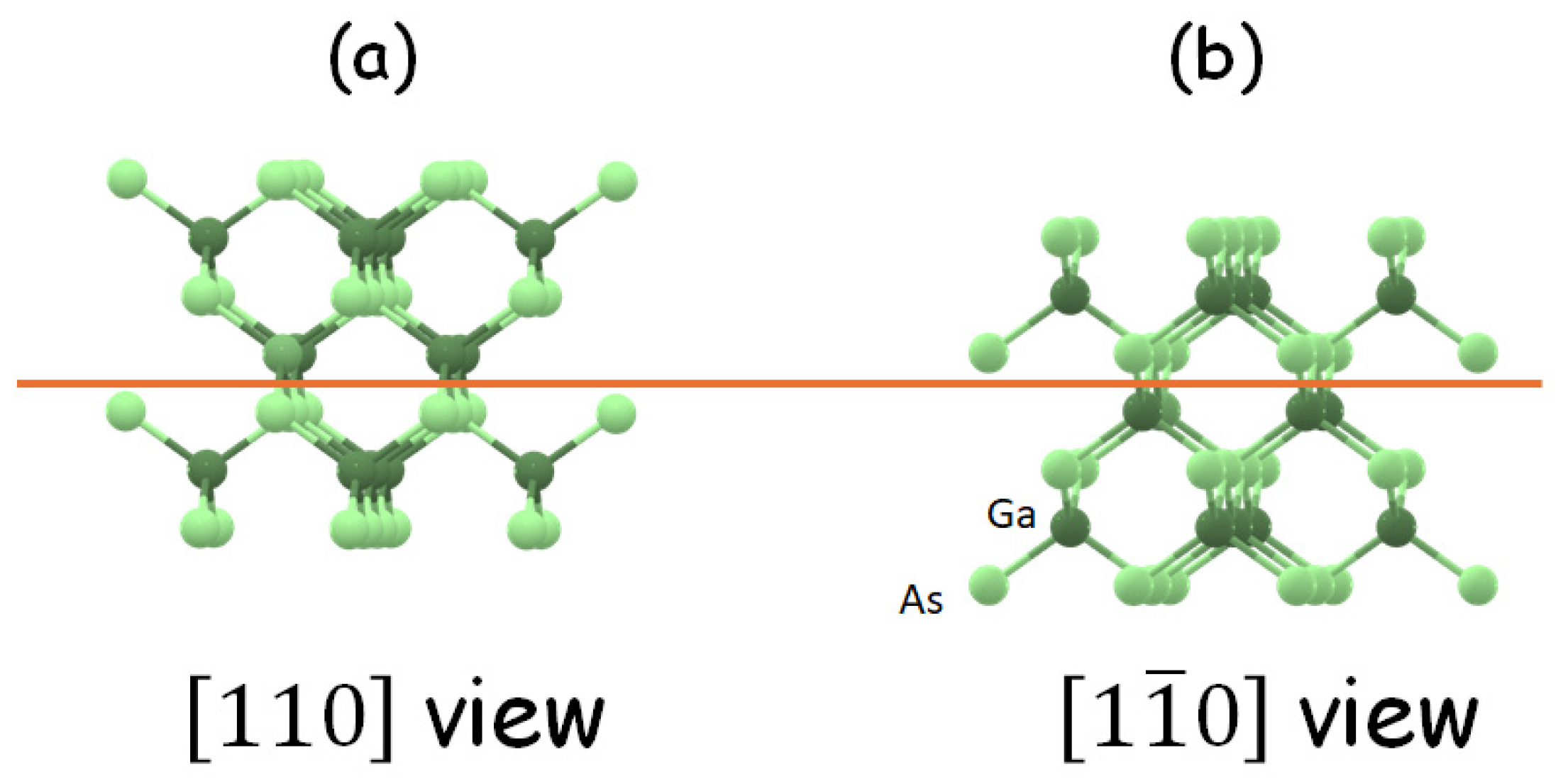
References
- Chernyshov, A.; Overby, M.; Liu, X.; Furdyna, J.K.; Lyanda-Geller, Y.; Rokhinson, L.P. Evidence for reversible control of magnetization in a ferromagnetic material by means of spin–orbit magnetic field. Nat. Phys. 2009, 5, 656–659. [Google Scholar] [CrossRef]
- Miron, I.M.; Gaudin, G.; Auffret, S.; Rodmacq, B.; Schuhl, A.; Pizzini, S.; Vogel, J.; Gambardella, P. Current-driven spin torque induced by the Rashba effect in a ferromagnetic metal layer. Nat. Mater. 2010, 9, 230–234. [Google Scholar] [CrossRef] [PubMed]
- Miron, I.M.; Garello, K.; Gaudin, G.; Zermatten, P.J.; Costache, M.V.; Auffret, S.; Bandiera, S.; Rodmacq, B.; Schuhl, A.; Gambardella, P. Perpendicular switching of a single ferromagnetic layer induced by in-plane current injection. Nature 2011, 476, 189–193. [Google Scholar] [CrossRef] [PubMed]
- Dresselhaus, G. Spin-orbit coupling effects in zinc blende structures. Phys. Rev. 1955, 100, 580. [Google Scholar] [CrossRef]
- Bychkov, Y.A.; Rashba, É.I. Properties of a 2D electron gas with lifted spectral degeneracy. JETP Lett. 1984, 39, 78–81. [Google Scholar]
- Bychkov, Y.A.; Rashba, É.I. Oscillatory effects and the magnetic susceptibility of carriers in inversion layers. J. Phys. C Solid State Phys. 1984, 17, 6039. [Google Scholar] [CrossRef]
- Ganichev, S.D.; Bel’kov, V.V.; Golub, L.E.; Ivchenko, E.L.; Schneider, P.; Giglberger, S.; Eroms, J.; De Boeck, J.; Borghs, G.; Wegscheider, W.; et al. Experimental Separation of Rashba and Dresselhaus Spin Splittings in Semiconductor Quantum Wells. Phys. Rev. Lett. 2004, 92, 256601. [Google Scholar] [CrossRef] [PubMed]
- Bernevig, B.A.; Zhang, S.C. Spin splitting and spin current in strained bulk semiconductors. Phys. Rev. B 2005, 72, 115204. [Google Scholar] [CrossRef]
- Manchon, A.; Zhang, S. Theory of spin torque due to spin-orbit coupling. Phys. Rev. B. 2009, 79, 094422. [Google Scholar] [CrossRef]
- D’yakonov, M.I. Spin relaxation of two-dimensional electrons in non-centrosymmetric semiconductors. Sov. Phys. Semicond. 1986, 20, 110–112. [Google Scholar]
- La Rocca, G.C.; Kim, N.; Rodriguez, S. Effect of uniaxial stress on the electron spin resonance in zinc-blende semiconductors. Phys. Rev. B 1988, 38, 7595. [Google Scholar] [CrossRef] [PubMed]
- Meier, L.; Salis, G.; Shorubalko, I.; Gini, E.; Schön, S.; Ensslin, K. Measurement of Rashba and Dresselhaus spin–orbit magnetic fields. Nat. Phys. 2007, 3, 650–654. [Google Scholar] [CrossRef]
- Kurebayashi, H.; Sinova, J.; Fang, D.; Irvine, A.C.; Skinner, T.D.; Wunderlich, J.; Novák, V.; Campion, R.P.; Gallagher, B.L.; Vehstedt, E.K.; et al. An antidamping spin–orbit torque originating from the Berry curvature. Nat. Nanotechnol. 2014, 9, 211–217. [Google Scholar] [CrossRef] [PubMed]
- Manchon, A.; Železný, J.; Miron, I.M.; Jungwirth, T.; Sinova, J.; Thiaville, A.; Garello, K.; Gambardella, P. Current-induced spin-orbit torques in ferromagnetic and antiferromagnetic systems. Rev. Mod. Phys. 2019, 91, 035004. [Google Scholar] [CrossRef]
- Ryu, J.; Lee, S.; Lee, K.J.; Park, B.G. Current-induced spin–orbit torques for spintronic applications. Adv. Mater. 2020, 32, 1907148. [Google Scholar] [CrossRef] [PubMed]
- Jiang, M.; Asahara, H.; Sato, S.; Kanaki, T.; Yamasaki, H.; Ohya, S.; Tanaka, M. Efficient full spin–orbit torque switching in a single layer of a perpendicularly magnetized single-crystalline ferromagnet. Nat. Commun. 2019, 10, 2590. [Google Scholar] [CrossRef] [PubMed]
- Jana, A.K.; Lee, S. Investigation of spin–orbit torque switching mechanism in crystalline ferromagnetic semiconductor. Appl. Phys. Lett. 2023, 123, 152401. [Google Scholar] [CrossRef]
- Levchenko, K. (Ga,Mn)(Bi,As) Dilute Magnetic Semiconductor—Characterization of the Layers and Electron Transport in Low-Dimensional Structures. Ph.D. Thesis, Institute of Physics, Polish Academy of Science, Warsaw, Poland, 2019. [Google Scholar]
- Yahyaoui, M.; Testelin, C.; Gourdon, C.; Boujdaria, K. The influence of the epitaxial strain on the magnetic anisotropy in ferromagnetic (Ga,Mn)(As,P)/GaAs thin films. J. Appl. Phys. 2012, 111, 033902. [Google Scholar] [CrossRef]
- Bac, S.K.; Lee, S.; Liu, X.; Dobrowolska, M.; Assaf, B.A.; Furdyna, J.K. Magnetic anisotropy of ferromagnetic Ga1−xMnxAs1−yPy films with graded composition. Phys. Rev. Mater. 2021, 5, 054414. [Google Scholar] [CrossRef]
- Bac, S.K.; Lee, S.; Liu, X.; Dobrowolska, M.; Furdyna, J.K. Effect of annealing on the magnetic anisotropy of GaMnAsP layers with graded P concentration. J. Vac. Sci. Technol. A 2023, 41, 022704. [Google Scholar] [CrossRef]
- Lee, S.; Chung, J.H.; Liu, X.; Furdyna, J.K.; Kirby, B.J. Ferromagnetic semiconductor GaMnAs. Mater. Today 2009, 12, 14–21. [Google Scholar] [CrossRef]
- Lee, H.; Chang, J.; Chongthanaphisut, P.; Lee, S.; Choi, S.; Bac, S.K.; Nasir, A.R.; Lee, S.; Pardo, A.; Dong, S.; et al. Magnetic anisotropy of quaternary GaMnAsP ferromagnetic semiconductor. AIP Adv. 2017, 7, 055809. [Google Scholar] [CrossRef]
- Li, X.; Liu, X.; Dong, S.; Gorsak, C.; Furdyna, J.K.; Dobrowolska, M.; Bac, S.K.; Lee, S.; Rouvimov, S. Dependence of ferromagnetic properties on phosphorus concentration in Ga1−xMnxAs1−yPy. J. Vac. Sci. Technol. B 2018, 36, 02D104. [Google Scholar] [CrossRef]
- Jana, A.K.; Lee, K.J.; Lee, S.; Liu, X.; Dobrowolska, M.; Furdyna, J.K. Magnetization switching by spin-orbit torque in crystalline (Ga,Mn)(As,P) film deposited on a vicinal GaAs substrate. Phys. Rev. B 2024, 110, 054422. [Google Scholar] [CrossRef]
- Park, S.; Lee, K.J.; Lee, S.; Liu, X.; Dobrowolska, M.; Furdyna, J.K. Spin–orbit torque switching in a single (Ga,Mn)(As,P) layer with perpendicular magnetic anisotropy. APL Mater. 2021, 9, 101102. [Google Scholar] [CrossRef]
- Jiang, M.; Asahara, H.; Sato, S.; Ohya, S.; Tanaka, M. Suppression of the field-like torque for efficient magnetization switching in a spin–orbit ferromagnet. Nat. Electron. 2020, 3, 751–756. [Google Scholar] [CrossRef]
- Park, S.; Lee, K.J.; Han, K.; Lee, S.; Liu, X.; Dobrowolska, M.; Furdyna, J.K. Spin orbit torque switching of magnetization in the presence of two different orthogonal spin–orbit magnetic fields. Appl. Phys. Lett. 2022, 121, 112403. [Google Scholar] [CrossRef]
- Kim, J.; Lee, H.; Yoo, T.; Lee, S.; Liu, X.; Furdyna, J.K. Effect of pinning-field distribution on the process of magnetization reversal in Ga1−xMnxAs films. Phys. Rev. B 2011, 84, 184407. [Google Scholar] [CrossRef]
- Lee, K.J.; Han, K.; Lee, S.; Liu, X.; Dobrowolska, M.; Furdyna, J.K. Multilevel states driven by spin-orbit torque in a P-composition graded (Ga, Mn)(As,P) film. AIP Adv. 2023, 13, 025122. [Google Scholar] [CrossRef]
- Lee, K.J.; Lee, S.; Liu, X.; Dobrowolska, M.; Furdyna, J.K. Two-field measurements of spin-orbit-torque efficiency in crystalline (Ga,Mn)(As,P) ferromagnetic semiconductors. Phys. Rev. B 2024, 110, 134425. [Google Scholar] [CrossRef]
- Zhang, P.X.; Liao, L.Y.; Shi, G.Y.; Zhang, R.Q.; Wu, H.Q.; Wang, Y.Y.; Pan, F.; Song, C. Spin-orbit torque in a completely compensated synthetic antiferromagnet. Phys. Rev. B 2018, 97, 214403. [Google Scholar] [CrossRef]
- Lee, K.J.; Lee, S.; Liu, X.; Dobrowolska, M.; Furdyna, J.K. Observation of field-free spin orbit torque switching in a single crys-talline (Ga,Mn)(As,P) ferromagnetic film with perpendicular anisotropy. APL Mater. 2024, 12, 121108. [Google Scholar] [CrossRef]
- Ishikuro, Y.; Kawaguchi, M.; Kato, N.; Lau, Y.C.; Hayashi, M. Dzyaloshinskii-Moriya interaction and spin-orbit torque at the Ir/Co interface. Phys. Rev. B 2019, 99, 134421. [Google Scholar] [CrossRef]
- Dai, Z.; Liu, W.; Zhao, X.; Liu, L.; Zhang, Z. Controllable spin–orbit torque efficiency in Pt/Co/Ru/Co/Pt multilayers with interlayer exchange couplings. ACS Appl. Electron. Mater. 2021, 3, 611–618. [Google Scholar] [CrossRef]
- Lee, K.J.; Lee, S.; Liu, X.; Dobrowolska, M.; Furdyna, J.K. Efficient spin-orbit torque magnetization switching with low current density in crystalline ferromagnetic semiconductor. IEEE Trans. Magn. 2024, 60, 2400105. [Google Scholar]
- Nagaosa, N.; Sinova, J.; Onoda, S.; MacDonald, A.H.; Ong, N.P. Anomalous Hall effect. Rev. Mod. Phys. 2010, 82, 1539–1592. [Google Scholar] [CrossRef]
- Han, K.; Lee, K.J.; Lee, S.; Liu, X.; Dobrowolska, M.; Furdyna, J.K. Field-free spin-orbit-torque switching of a single ferromagnetic layer with fourfold in-plane magnetic anisotropy. APL Mater. 2023, 11, 081114. [Google Scholar] [CrossRef]
- Limmer, W.; Glunk, M.; Daeubler, J.; Hummel, T.; Schoch, W.; Sauer, R.; Bihler, C.; Huebl, H.; Brandt, M.S.; Goennenwein, S.T. Angle-dependent magnetotransport in cubic and tetragonal ferromagnets: Application to (001)-and (113) A-oriented (Ga,Mn)As. Phys. Rev. B 2006, 74, 205205. [Google Scholar] [CrossRef]
- Limmer, W.; Daeubler, J.; Dreher, L.; Glunk, M.; Schoch, W.; Schwaiger, S.; Sauer, R. Advanced resistivity model for arbitrary magnetization orientation applied to a series of compressive-to tensile-strained (Ga,Mn)As layers. Phys. Rev. B 2008, 77, 205210. [Google Scholar] [CrossRef]
- Bihler, C.; Althammer, M.; Brandlmaier, A.; Geprägs, S.; Weiler, M.; Opel, M.; Schoch, W.; Limmer, W.; Gross, R.; Brandt, M.S.; et al. Ga1−xMnxAs/piezoelectric actuator hybrids: A model system for magnetoelastic magnetization manipulation. Phys. Rev. B 2008, 78, 045203. [Google Scholar] [CrossRef]
- Glunk, M.; Daeubler, J.; Dreher, L.; Schwaiger, S.; Schoch, W.; Sauer, R.; Limmer, W.; Brandlmaier, A.; Goennenwein, S.T.; Bihler, C.; et al. Magnetic anisotropy in (Ga,Mn)As: Influence of epitaxial strain and hole concentration. Phys. Rev. B 2009, 79, 195206. [Google Scholar] [CrossRef]
- Han, K.; Lee, K.J.; Lee, S.; Liu, X.; Dobrowolska, M.; Furdyna, J.K. Investigation of orthogonal spin-orbit fields in crystalline ferromagnetic films with 4-fold in-plane magnetic anisotropy. APL Mater. 2023, 11, 051114. [Google Scholar] [CrossRef]
- Li, Y.; Cao, Y.F.; Wei, G.N.; Li, Y.; Ji, Y.; Wang, K.Y.; Edmonds, K.W.; Campion, R.P.; Rushforth, A.W.; Foxon, C.T.; et al. Anisotropic current-controlled magnetization reversal in the ferromagnetic semiconductor (Ga,Mn)As. Appl. Phys. Lett. 2013, 103, 022401. [Google Scholar] [CrossRef]
- Lee, S.; Choi, S.; Bac, S.K.; Jae Lee, K.; Chang, J.; Choi, S.; Chongthanaphisut, P.; Lee, S.; Liu, X.; Dobrowolska, M.; et al. Determination of current-induced spin-orbit effective magnetic field in GaMnAs ferromagnetic semiconductor. Appl. Phys. Lett. 2017, 111, 252401. [Google Scholar] [CrossRef]
- Park, S.; Lee, S.; Lee, K.J.; Park, S.; Chongthanaphisut, P.; Jang, J.; Lee, S.; Liu, X.; Dobrowolska, M.; Furdyna, J.K. Quantitative determination of spin–orbit-induced magnetic field in GaMnAs by field-scan planar Hall measurements. Sci. Rep. 2021, 11, 10263. [Google Scholar] [CrossRef]
- Jana, A.K.; Lee, S. Anisotropy dependent spin-orbit torque switching in crystalline ferromagnetic semiconductor. IEEE Trans. Magn. 2024, 60, 4100205. [Google Scholar]
- Wang, C.; Jiang, M.; Ohya, S.; Tanaka, M. Quantitative characterization of current-induced self-spin–orbit torques in a perpendicularly magnetized (Ga,Mn)As single thin film. Appl. Phys. Lett. 2023, 123, 152402. [Google Scholar] [CrossRef]
- Vlasko-Vlasov, V.K.; Kwok, W.K.; Dong, S.; Liu, X.; Dobrowolska, M.; Furdyna, J.K. Extreme asymmetry of Néel domain walls in multilayered films of the dilute magnetic semiconductor (Ga,Mn)(As,P). Phys. Rev. B 2018, 98, 180411. [Google Scholar] [CrossRef]
- Bac, S.K.; Liu, X.; Dobrowolska, M.; Lee, S.; Furdyna, J.K. Effect of non-local growth dynamics on magnetic properties of composition-graded Ga1−xMnxAs1−yPy ferromagnetic films. Acta Phys. Pol. A 2022, 141, 149–155. [Google Scholar] [CrossRef]
- Liu, X.; Smith, D.J.; Fan, J.; Zhang, Y.H.; Cao, H.; Chen, Y.P.; Leiner, J.; Kirby, B.J.; Dobrowolska, M.; Furdyna, J.K. Structural properties of Bi2Te3 and Bi2Se3 topological insulators grown by molecular beam epitaxy on GaAs (001) substrates. Appl. Phys. Lett. 2011, 99, 171903. [Google Scholar] [CrossRef]
- Goel, S.; Khang, N.H.; Osada, Y.; Anh, L.D.; Hai, P.N.; Tanaka, M. Room-temperature spin injection from a ferromagnetic semiconductor. Sci. Rep. 2023, 13, 2181. [Google Scholar] [CrossRef] [PubMed]
- Ishizaka, K.; Bahramy, M.S.; Murakawa, H.; Sakano, M.; Shimojima, T.; Sonobe, T.; Koizumi, K.; Shin, S.; Miyahara, H.; Kimura, A.; et al. Giant Rashba-type spin splitting in bulk BiTeI. Nat. Mater. 2011, 10, 521–526. [Google Scholar] [CrossRef] [PubMed]
- Wang, H.; Gopal, P.; Picozzi, S.; Curtarolo, S.; Buongiorno Nardelli, M.; Sławińska, J. Spin Hall effect in prototype Rashba ferroelectrics GeTe and SnTe. npj Comput. Mater. 2020, 6, 7. [Google Scholar] [CrossRef]
- MacNeill, D.; Stiehl, G.M.; Guimaraes, M.H.; Buhrman, R.A.; Park, J.; Ralph, D.C. Control of spin–orbit torques through crystal symmetry in WTe2/ferromagnet bilayers. Nat. Phys. 2017, 13, 300–305. [Google Scholar] [CrossRef]
- Liu, Y.; Shao, Q. Two-dimensional materials for energy-efficient spin–orbit torque devices. ACS Nano 2020, 14, 9389–9407. [Google Scholar] [CrossRef]
- Andrearczyk, T.; Sadowski, J.; Dybko, K.; Figielski, T.; Wosinski, T. Current-induced magnetization reversal in (Ga,Mn)(Bi,As) epitaxial layer with perpendicular magnetic anisotropy. Appl. Phys. Lett. 2022, 121, 242401. [Google Scholar] [CrossRef]
- Kobayashi, M.; Anh, L.D.; Hai, P.N.; Takeda, Y.; Sakamoto, S.; Kadono, T.; Okane, T.; Saitoh, Y.; Yamagami, H.; Harada, Y.; et al. Spin and orbital magnetic moments of Fe in the n-type ferromagnetic semiconductor (In,Fe)As. Appl. Phys. Lett. 2014, 105, 032403. [Google Scholar] [CrossRef]
- Tu, N.T.; Hai, P.N.; Anh, L.D.; Tanaka, M. Magnetic properties and intrinsic ferromagnetism in (Ga,Fe)Sb ferromagnetic semiconductors. Phys. Rev. B 2015, 92, 144403. [Google Scholar] [CrossRef]
- Sztenkiel, D.; Gas, K.; Szwacki, N.G.; Foltyn, M.; Sliwa, C.; Wojciechowski, T.; Domagala, J.Z.; Hommel, D.; Sawicki, M.; Dietl, T. Electric field manipulation of magnetization in an insulating dilute ferromagnet through piezoelectromagnetic coupling. arXiv 2024, arXiv:2406.13534. [Google Scholar]
- Przybylińska, H.; Springholz, G.; Lechner, R.T.; Hassan, M.; Wegscheider, M.; Jantsch, W.; Bauer, G. Magnetic-Field-Induced Ferroelectric Polarization Reversal in the Multiferroic Ge1-xMnxTe Semiconductor. Phys. Rev. Lett. 2014, 112, 047202. [Google Scholar] [CrossRef]
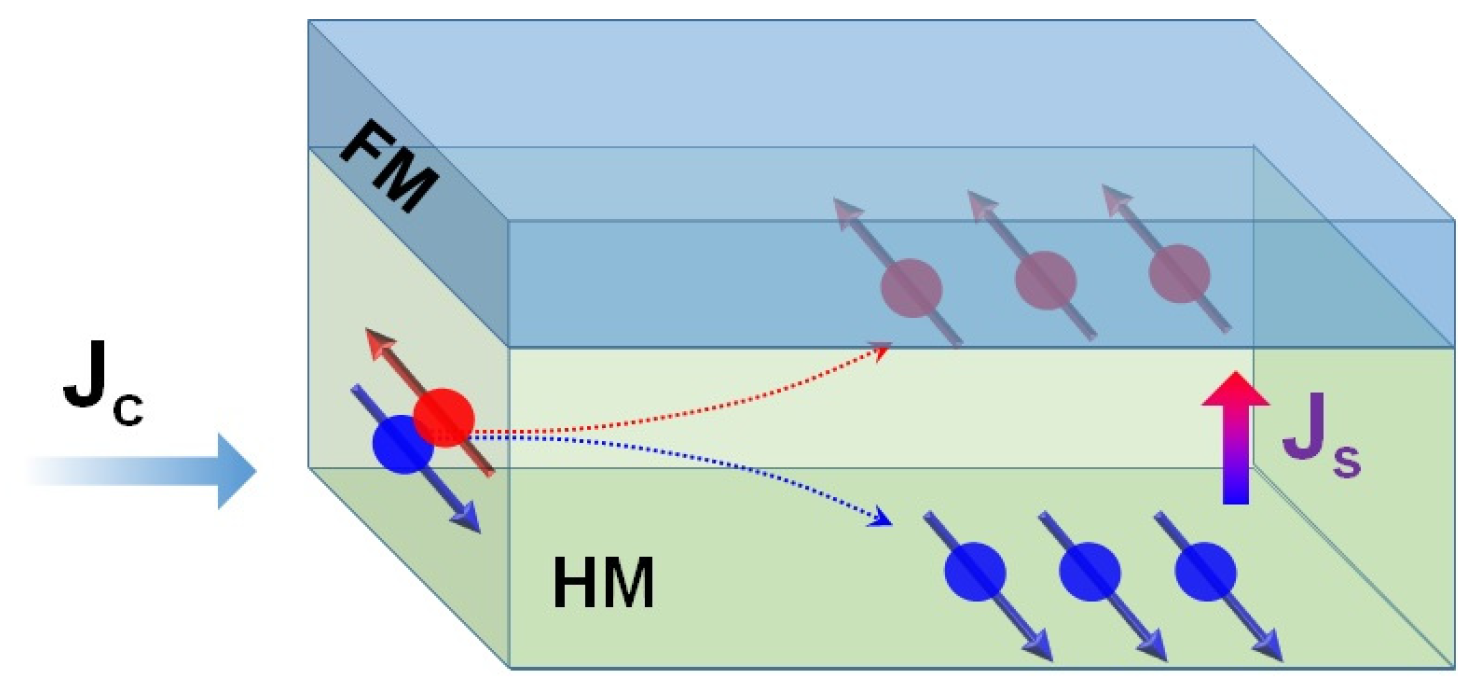
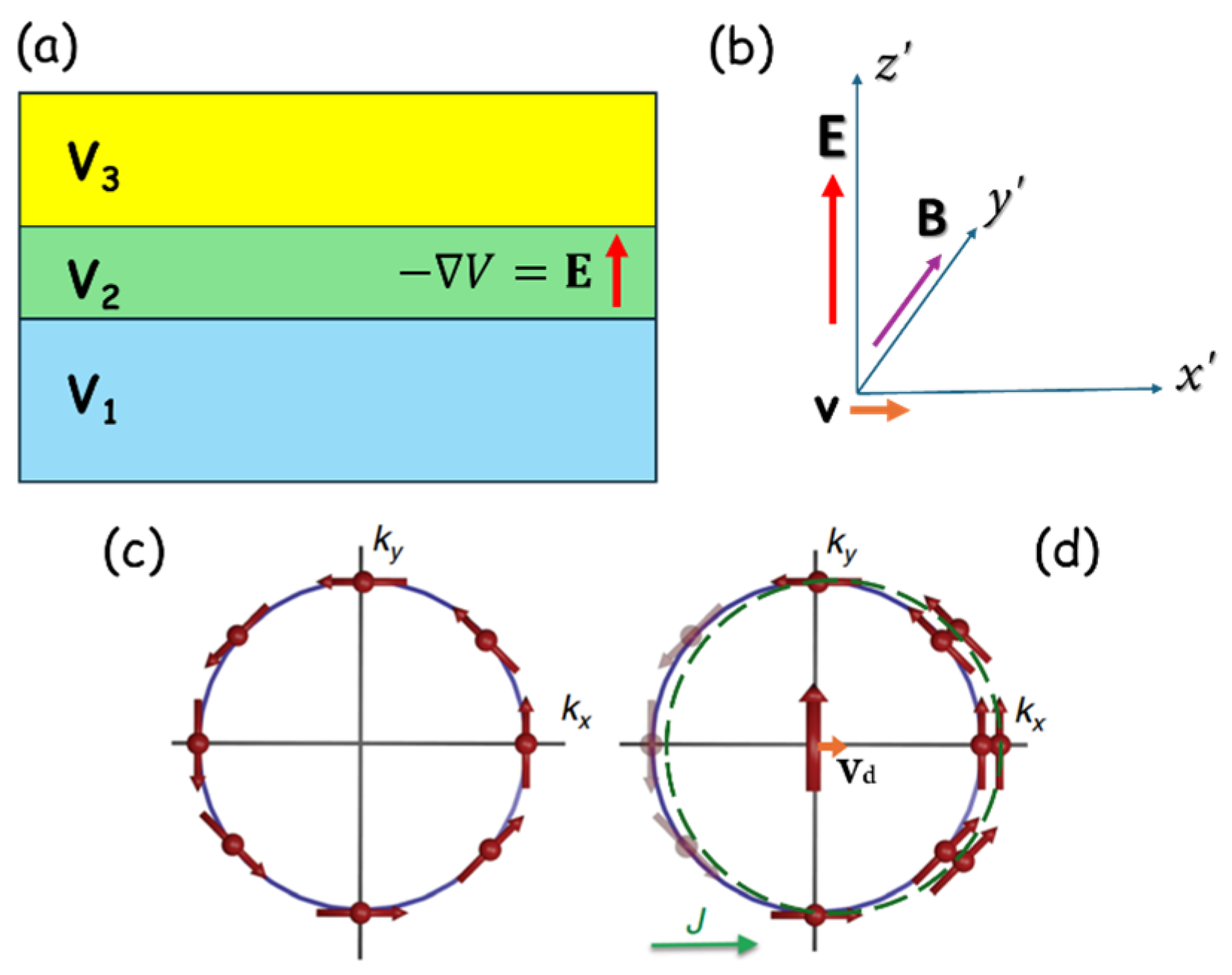


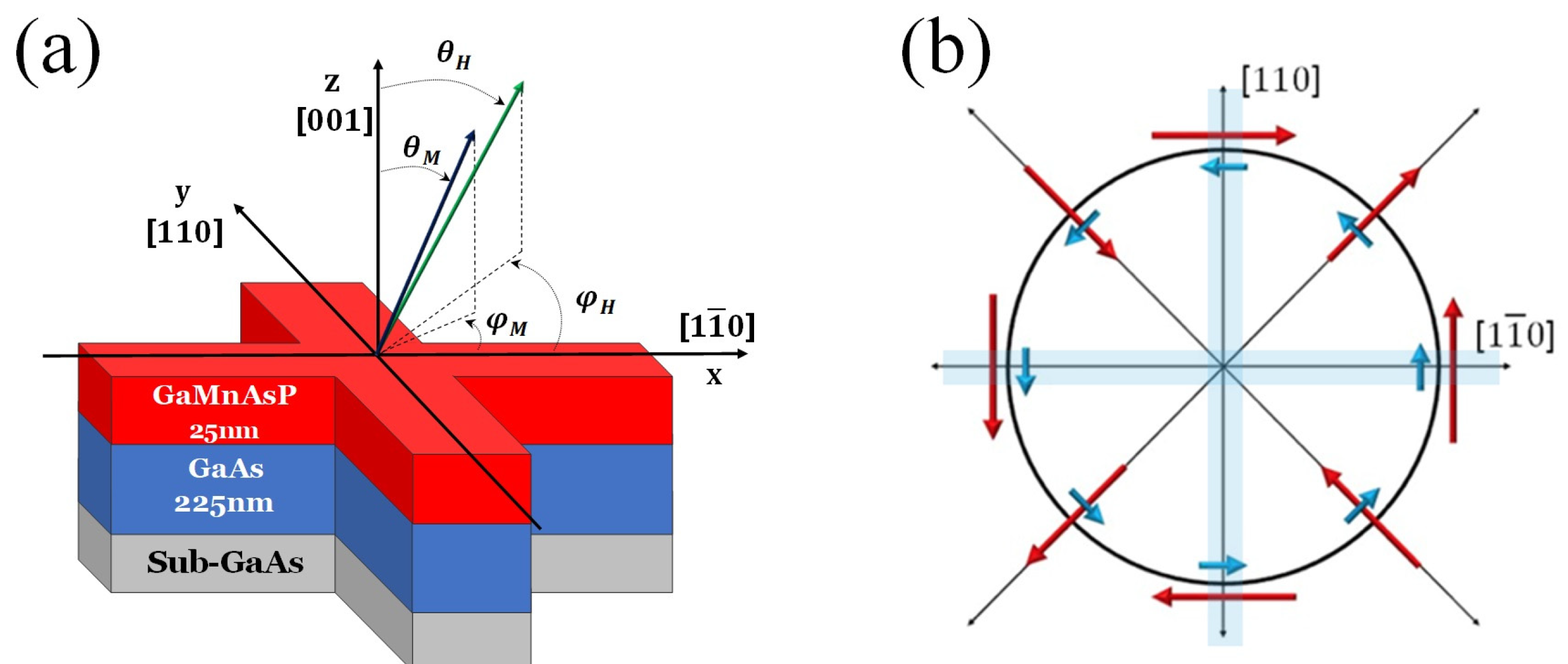

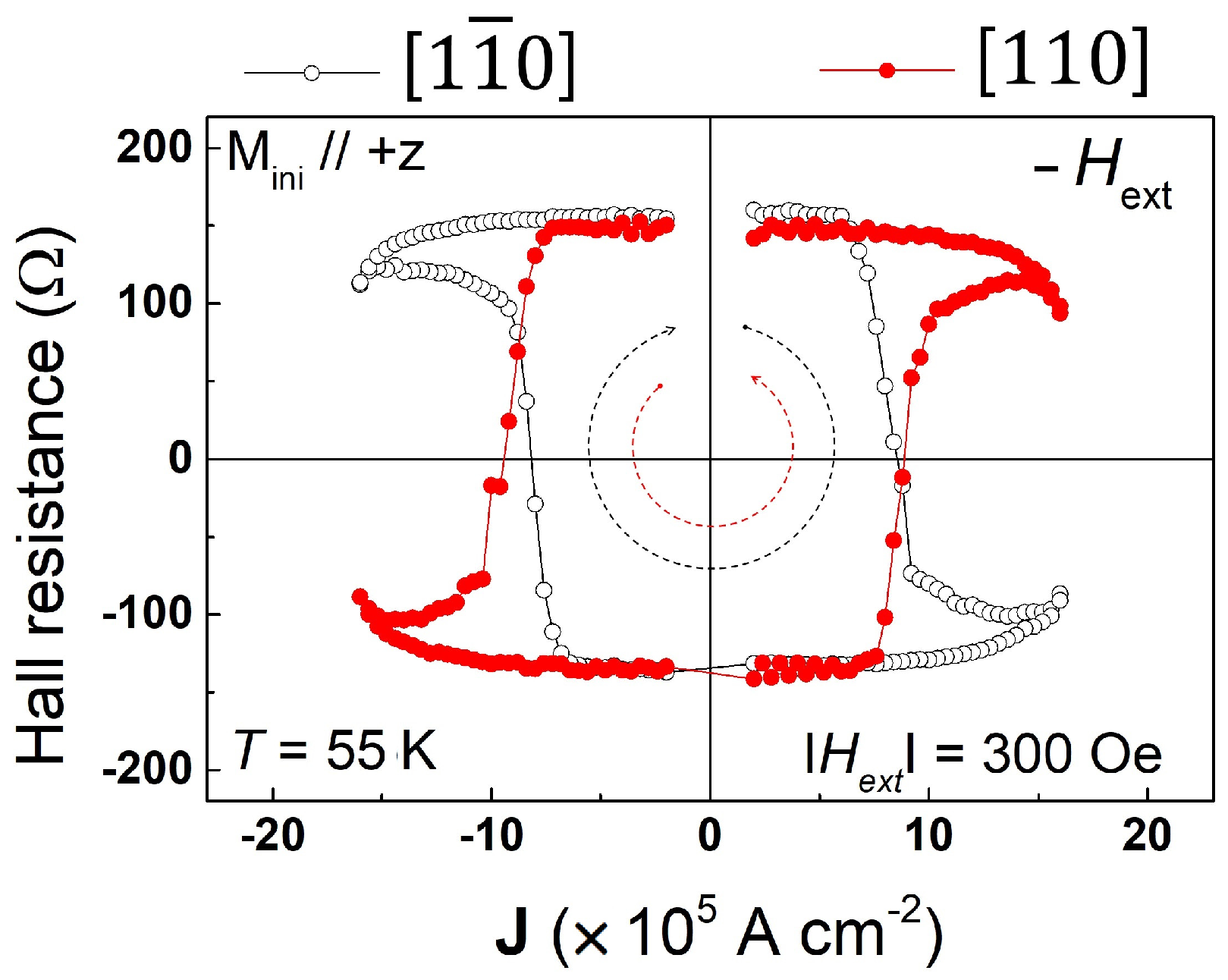
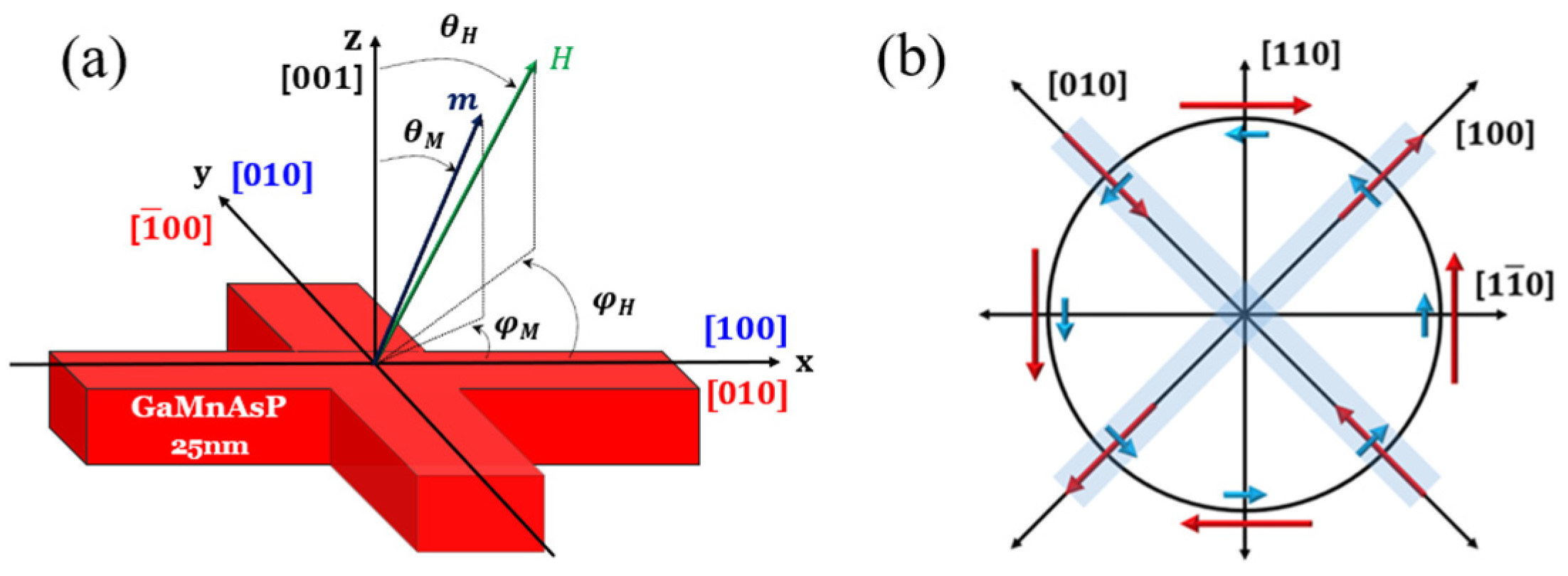
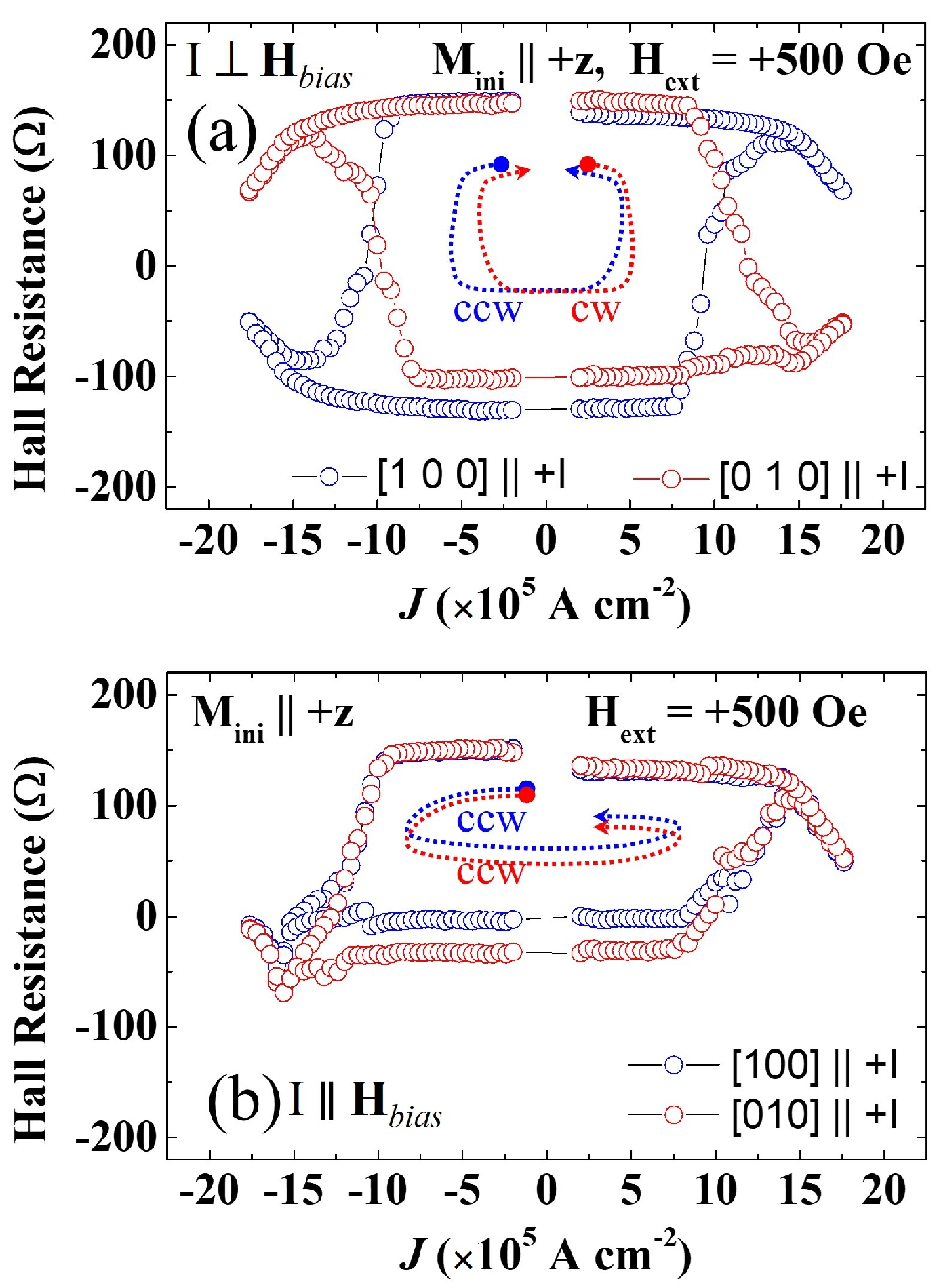



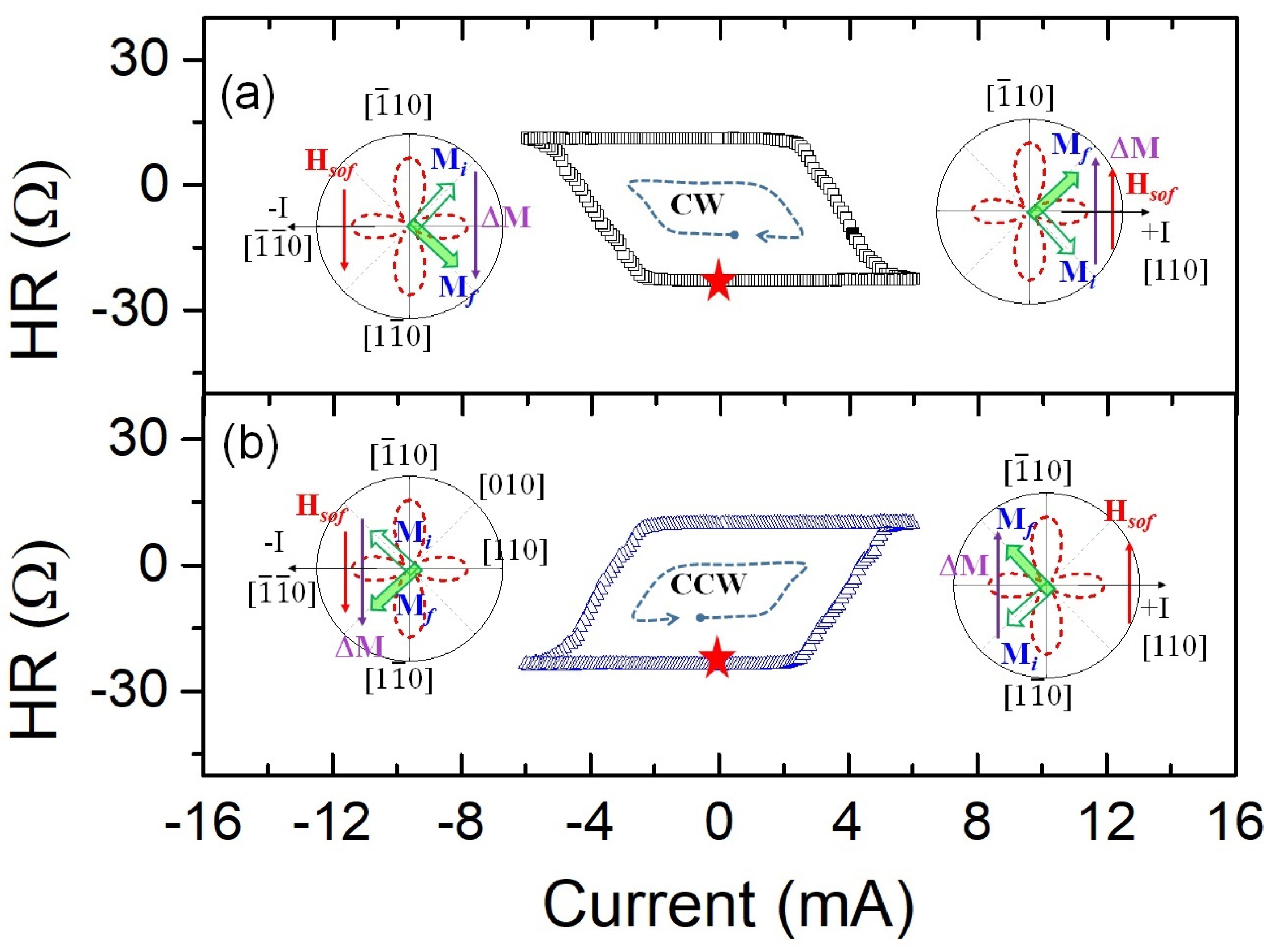
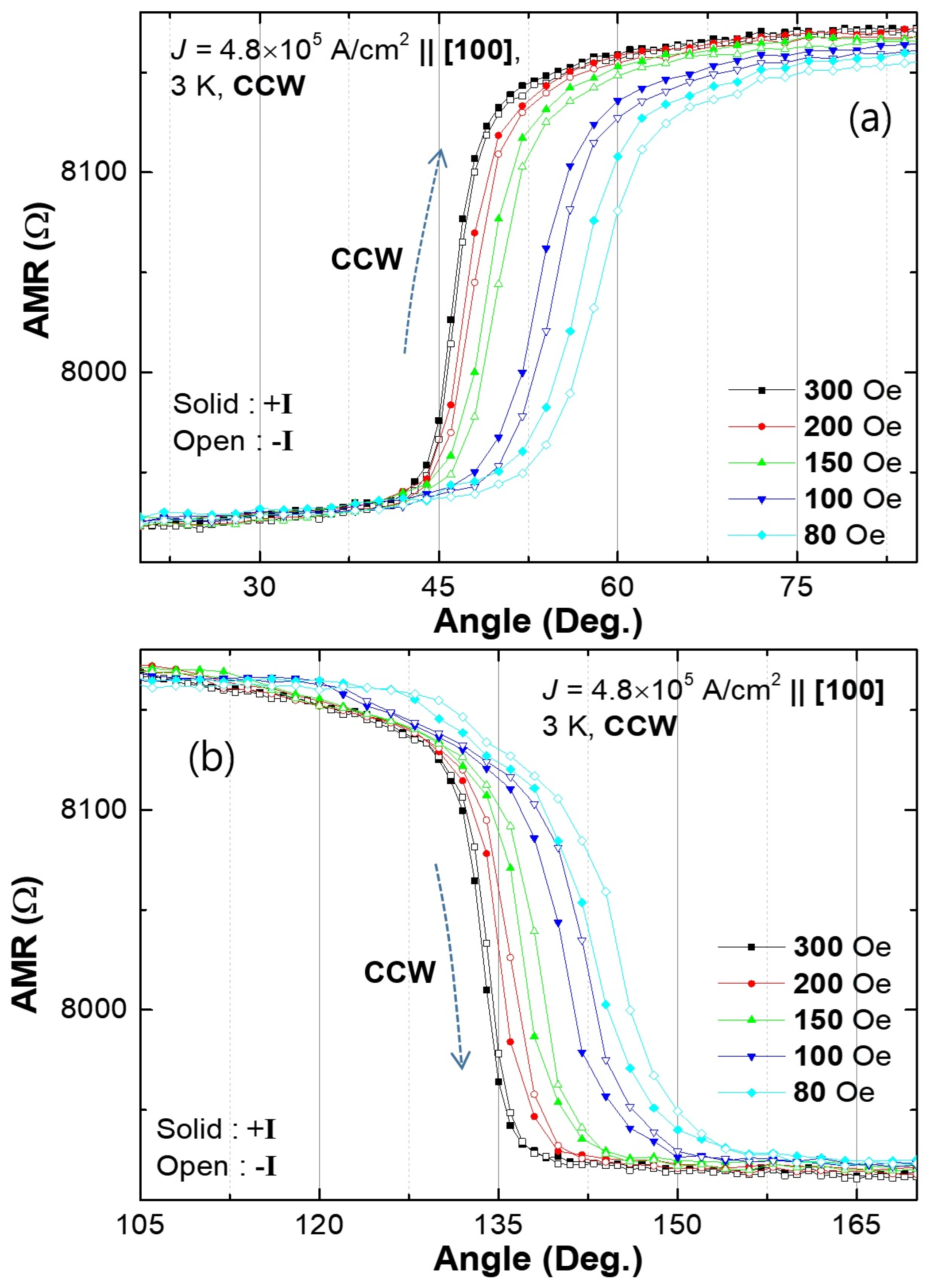

Disclaimer/Publisher’s Note: The statements, opinions and data contained in all publications are solely those of the individual author(s) and contributor(s) and not of MDPI and/or the editor(s). MDPI and/or the editor(s) disclaim responsibility for any injury to people or property resulting from any ideas, methods, instructions or products referred to in the content. |
© 2025 by the authors. Licensee MDPI, Basel, Switzerland. This article is an open access article distributed under the terms and conditions of the Creative Commons Attribution (CC BY) license (https://creativecommons.org/licenses/by/4.0/).
Share and Cite
Lee, S.; Liu, X.; Furdyna, J. Controlling Magnetization in Ferromagnetic Semiconductors by Current-Induced Spin-Orbit Torque. Materials 2025, 18, 271. https://doi.org/10.3390/ma18020271
Lee S, Liu X, Furdyna J. Controlling Magnetization in Ferromagnetic Semiconductors by Current-Induced Spin-Orbit Torque. Materials. 2025; 18(2):271. https://doi.org/10.3390/ma18020271
Chicago/Turabian StyleLee, Sanghoon, Xinyu Liu, and Jacek Furdyna. 2025. "Controlling Magnetization in Ferromagnetic Semiconductors by Current-Induced Spin-Orbit Torque" Materials 18, no. 2: 271. https://doi.org/10.3390/ma18020271
APA StyleLee, S., Liu, X., & Furdyna, J. (2025). Controlling Magnetization in Ferromagnetic Semiconductors by Current-Induced Spin-Orbit Torque. Materials, 18(2), 271. https://doi.org/10.3390/ma18020271







